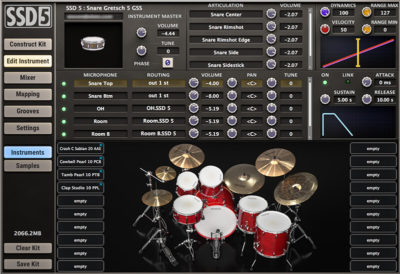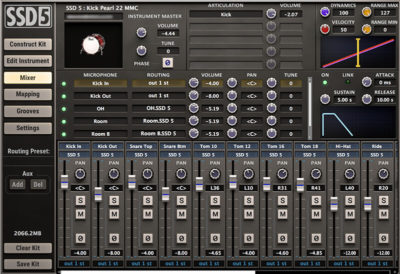New Software Review: Steven Slate Drums 5
In 2006, Slate Digital released one of the industry’s earlier professional drum sample products, Steven Slate Drums.
With radio-ready samples and patterns available at the click of a mouse, SSD 1 was an instant success.
Over the years, the Slate drum library continued to grow with more samples and new releases, until 2011 when SSD 4 was released. As the company’s attention began to shift to analog-modeled plugins, fans of the SSD software were left waiting for an update—until now.
Originally announced for a 2014 release, the highly anticipated Steven Slate Drums 5 is finally here. It features an all-new user interface, upgraded performance algorithm, and a massive drum library with over 50 new instruments. In this review, we’re putting SSD 5 to the test to see how it stacks up against the competition.
Features
As soon as you open SSD 5 you’re greeted with the Construct Kit page, where you can select a pre-made kit from the preset library. Choose from dozens of presets for modern and vintage kits, perfect for any genre; from rock, metal, and indie to jazz, country, funk, and reggae. SSD 5 even has a number of electronic kit presets for house, electro, and more.
The Deluxe 2 library features the most detailed instruments, with more velocities, alternating hits, and articulations than previous versions. The Deluxe 1 library is an updated version of the SSD 4 library, which utilizes the new “physically modeled drum playback algorithm” to model the behavior of a real drum kit. SSD 5 is also the only product on the market that allows you to adjust the curve shape of each ADSR phase, which enables you to emulate compressors, transient processors, and more.
The Classic Vol. 1, Classic Vol. 2, and Classic Signature libraries are from the first three iterations of SSD, and only offer one mono direct mic and one stereo room mic per instrument. The SSD 5 Electronic library features a collection of vintage and modern electronic drum sounds.
You can also build your own custom kit using over 400 included instruments. Each instrument is made up of multiple 24-bit multi-mic WAV samples saved in a proprietary format using lossless compression. Drum instruments have up to 24 velocity layers and feature 12 alterations or “round-robin” hits, making them sound more lifelike. You can even load your own custom 16/24-bit 44.1 kHz WAV files as one-shots.
Engage the Audition button in the top right corner to audition samples before loading them. To load a sample, simply drag and drop it onto the interactive drum kit, or place it in the additional sample sections on the left or right. You can save your kit or clear it and start from scratch using the Save and Clear buttons on the left side. You can also toggle the snare mode from classic to rimshot, which adds a rimshot when the snare is triggered with maximum velocity.
After selecting or building your kit, you can tweak each instrument by clicking the Edit Instrument tab. This replaces the sample library menu with a new interface that allows you to adjust velocity curves, articulation volume, mic volume, panning, and more. In the Instrument section, you can adjust master volume, change the pitch of a drum, and even flip the phase.
The Articulations section allows you to audition and adjust the volume of any articulation, such as hi-hat pedal, snare ring, or the new SLR channel, which is a dedicated channel for the bleed from the kick and toms into the snare bottom mic. This allows you to adjust the level of snare rattle every time an adjacent drum is hit.
The Dynamics section features an aptly named dynamics control, which adjusts the volume difference between soft hits and hard hits. Use the velocity control to quickly increase or decrease the velocity of an entire performance.
The Microphone section allows you to balance levels between multiple mics, like Kick In, Kick Out, Overheads, Room A, and Room B. Alternately, you can create your own custom routing for advanced control. In the ADSR section, you can adjust the attack, decay, sustain, and release curves for each sample, allowing you to dial in custom transient responses across the kit.
For an expanded view of your entire mix, select the Mixer tab, which opens up a traditional console-style mixer in the bottom half of the window. Each channel is color-coded, with close mics in blue, one-shot samples in bronze, ambient mics in violet, and aux channels in pink.
You can also manually route channels from the mixer by selecting outputs for each mic, or automatically via Routing Presets. According to the manual, using Multi-Out “unlocks the most powerful and detailed drum sound.” SSD 5 has 16 stereo and 16 mono routing channels, equaling a total of 48.
When building custom kits, you can create your own key mapping using the Mapping tab. Simply drag and drop samples to the desired key. And if you’re looking for a little inspiration, open up the Grooves tab for hundreds of pre-made drum loops played by real drummers in five different styles. Each style features multiple songs, which are broken into parts like verse, chorus, and bridge. You can audition loops from the library and simply drag and drop them into your DAW to create MIDI performances.
In Use
Since I’m not a professional finger-drummer, I decided to use the pre-made Grooves in SSD 5 for this review. This turned out to be a great decision, as they really show off the advanced articulations the program is capable of.
First, I tested out two rock grooves with the Savage Rock kit and the New Metal kit. Next, I tried an R&B groove with Funk kit. Then I used a pop groove with a Vintage 60s kit in classic Beatles fashion. I tested out a jazz groove on a jazz kit, and finally, I tried a soul groove with an old-school electronic hip hop kit for a lo-fi vibe.
Click here to download the full resolution audio samples.
To Be Critical
These days, there are plenty of plugins that can trigger drum samples. What you’re really getting when you purchase SSD 5 is the sample library, which sounds amazing. Every preset kit is perfectly balanced, and the massive library of raw instruments give you plenty to work with when creating custom kits.
The articulations offer a ton of sonic variety and increased control over each sample. The dedicated snare ring and bleed channels are huge time-savers when mixing.
However, one thing that still feels lacking in SSD 5 is cymbal swells. Even though SSD 5 features more round-robin cymbal hits than any other drum software, cymbal rolls don’t feel like they share the same realism, depth, and detail as the snare and tom rolls. Slate notes that they plan to add real cymbal swells to SSD 5 in the next update.
Another big concern is the MIDI mapping system. While Slate did rework their mapping for SSD 5, it’s still extremely cumbersome. User mapping requires you to drag and drop each sample one at a time, making it difficult to create custom kits. For instance, dragging a kick drum into one of the aux sample slots automatically assigns it to the same channel as every other kick in the kit, making it impossible to play them independently without remapping. You also can’t delete a sample from a key—you have to drag it to an unused key. That said, Slate also plans to implement MIDI learning into SSD 5 in the next update.
Summing it Up
Overall I was very impressed with Steven Slate Drums 5. If you’re looking for a new drum machine to trigger your custom kits, you may want to keep looking, but if you’re looking for a collection of radio-ready drum samples and realistic grooves in a wide range of genres and styles, SSD 5 is well worth the money at just $149. And if you previously owned SSD 4, you can pick it up for as little as $99.
While SSD 5 does have some room to grow in terms of customization, it’s incredibly easy to quickly dial in a realistic drum performance. And while SSD 5 clearly shines in the rock and metal genres, it’s packed with plenty of great kits for other genres as well. The bottom line is, if you’re a rock or metal producer who frequently works with sampled drums, SSD 5 is a must-have.
Brad Pack is an award-winning audio engineer and writer based in Chicago, IL. He currently owns and operates Punchy Kick, a professional mixing and mastering studio that specializes in pop punk, emo, punk, grunge, and alternative music.
He has been helping artists connect with fans through emotionally resonant mixes, cohesive masters, and insightful guidance for over 10 years. Check out his website PunchyKick.com or say hi on Instagram @PunchyKick.
Please note: When you buy products through links on this page, we may earn an affiliate commission.









[…] Over the years, the Slate drum library continued to grow with more samples and new Read more… […]